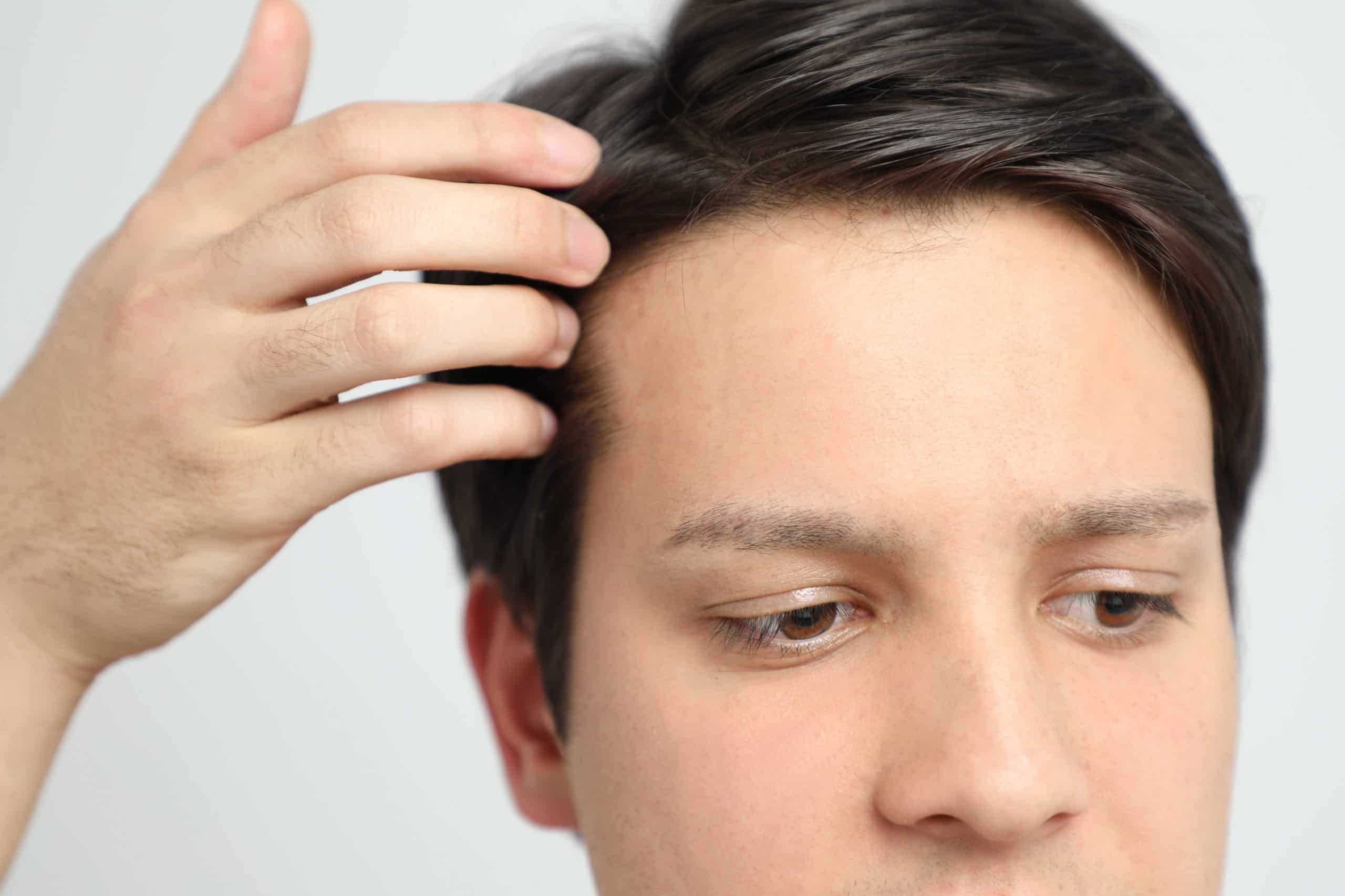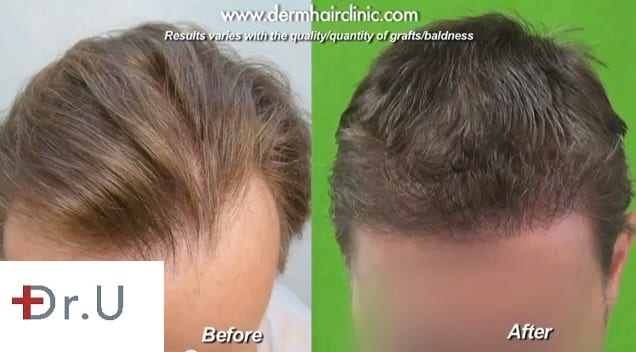Article Update:
Depending on the severity of your hair loss, natural, non-surgical means may help reduce hair loss and, in some cases, help promote hair growth. Natural plant-based hair products such as Dr.UGro Gashee Natural Hair Products, invented using proprietary and novel processing methods by Dr. Umar, have been successful in some patients in helping them thicken hair, increase hair density, and improve hair health. Some of these happy and satisfied Gashee patients can be seen here.
VIDEO: Men’s Natural Hair Product – Before & After Hair Health Results Using Gashee
Stop Men’s Hair Loss with Gashee!
This man was on a mission to stop his hair loss – and with the help of Dr.UGro Gashee Hair Care Products, he was able to do exactly that!If you have been exp…
Male Hairpiece Usage and Its Social Pitfalls – Why Do Men Use Toupees? A male hairpiece, also referred to as a hair system, toupee, or wig, is often used to conceal baldness. In the United States, 40% of men will experience hair loss by age 35. For some of these men, hairpieces offer a sense of relief. They are made of artificial hair and applied to balding areas. Some are glued on or clipped onto the scalp meant to mimic and emulate natural hair, creating the appearance of a fuller head of hair.
Market Watch states, “The global Toupee market Growth is anticipated to rise at a considerable rate during the forecast period, between 2021 and 2025.” The average cost of male hairpieces ranges from $100-$2000. Sophisticated non-surgical hair replacement systems are usually priced under $1000. Some solutions require about $60-$300 just for maintenance alone. Another appealing advantage of wigs, hairpieces, and hair systems is the lack of healing and recovery time. Their coverage improvements offer instant gratification. And with celebrities like Jason Alexander, who openly share that they wear artificial hair, many men (especially in the entertainment industry) are open to doing the same.
However, fake hairpieces for men don’t offer a permanent solution but a temporary aesthetic one.

Male Hairpiece Types
There are different types of hairpieces designed to conceal male pattern baldness. They are generally categorized by how they are attached to the head.
Semi-Permanent Attached Hairpiece
This type of hair system uses one of two methods to attach the hairpiece to the head:
1. A glue adhesive to adhere the underside of the hairpiece to the head. Examples include poly bonds, natural bonds, and polyfuse.
2. A weaving technique to weave the individual’s hair to the base of the male hairpiece.
The removal of Semi-permanent attached hairpieces requires a stylist or technician. Although manufacturers recommend these visits every six weeks, the American Hair Loss Association advocates that removals are performed every five days since oil cleans out the buildup of shed hair and flakes of skin underneath the hairpiece.
Temporary Adhesive-Attached Male Hairpiece
This hair system uses double-sided tape to affix the hairpiece to the scalp. Although this type of adhesion is much easier to remove than glue, the tape can quickly come off due to moisture from the rain, swimming, and sweat.
Clip Attachment Hairpiece
Instead of tape or glue, metal clips are used to attach the hairpiece to the head. Although this method makes removing much more accessible, the hair system is less securely attached to the head, making them more susceptible to mishaps.
The Social Pitfalls of Fake Hairpieces for Men
Though hairpieces are popular, the male hairpiece comes with several disadvantages. Here are a few areas of real-life social pitfalls:
Inauthenticity
When wearing hairpieces, there’s a risk that they will fall off or need readjustment. Although men wear hairpieces, so they no longer appear bald, the risks of wearing a wig involve looking inauthentic. Since there is a chance that a hairpiece can fall off, men can feel discouraged from engaging in activities that require a lot of movements like dancing, climbing, or running. Ironically, these activities, meant to instill confidence in males, become a source of insecurities for hairpiece users.
Maintenance
To look passably authentic, a male hairpiece requires constant maintenance. This could be awkward and inconvenient for men. Instead of making men feel comfortable with their appearance, this constant maintenance could be a hassle and time-consuming, making it more challenging to get ready before leaving the house.
Weather
Toupees and male hairpieces can fly off with a gush of wind or completely unravel when it starts to rain. This can be a significant hurdle for social situations, traveling, and daily life. Although thinning hair can make men insecure, publicly exposing your toupee because of the weather could be a horrible, embarrassing experience.
Shame
Men who wear hairpieces can often feel shame about lying to their romantic partners, friends, or family. Wearing a male hairpiece can lead to awkward situations like explaining them to a romantic partner before intimacy. Besides, when a toupee slips out of place, falls off, or needs to be replaced, men are forced to explain them to their friends and romantic partners. Experiencing hair loss can be stressful and embarrassing. There’s no reason men need to feel ashamed about how they want to deal with their hairline on top of that experience.

Hair Loss Solutions: It’s Time to Take Off The Toupee
Though many people use toupees, there’s a wide range of alternative solutions for hair loss and thinning that doesn’t come with the potential social pitfalls. Some men take prescription pills like Propecia, while others apply Minoxidil on balding areas. However, these treatments have side effects and don’t necessarily offer a long-term solution. Many men undergo Follicular Unit Extraction (FUE) surgery to combat baldness. Here are some of the advantages of FUE :
- No scars or stitches
- More authentic appearance
- It gives you the ability to have a flexibility of styles and short haircuts.
- Relatively fast recovery (compared to the more invasive strip hair transplant procedure)
Achieving outstanding results will depend on choosing a highly experienced hair transplant surgeon. The right doctor will help ensure graft survival for growth and recreate natural hair growth patterns. There is no need to worry about the inconvenience and possible embarrassing mishaps associated with hairpieces with excellent results.

One of the reasons men resort to hairpieces is severe baldness, in which case; conventional hair transplantation techniques will not meet the challenge of providing a credible-looking hair restoration outcome. This is because conventional hair transplantation methods rely solely on donor hair supply from the head’s back and sides. Since the maximum hair graft supply obtained from the head donor is about 7000-8000 in severe baldness such as level 7, where a minimum of 12000 and more grafts are needed, these hair transplant techniques would fall short. Hair transplant clinics turn most of these patients away as poor candidates. However, advances in hair transplant techniques have enabled harvesting additional donor grafts from outside the head areas such as the beard, chest, stomach area, arms, and legs. This expansion of the donor pool has allowed for the grafting of even severely bald patients. [1,2] The procedure called body hair transplantation pioneered and advanced by Dr. Sanusi Umar using the UGraft FUE system has proven very successful in providing credible restoration for severely deficient patients to avoid or abandon the use of hairpieces. The ability to expand the donor pool in this manner also opens repair and restoration opportunities for patients whose head donor has been inefficiently depleted from poorly executed previous hair surgeries. In that case, the patient would require hair grafts sourced from other areas such as the beard and body to credibly repair and restore a hair loss situation that might not be severe.
Are you interested in real hair growth (and not a wig) to overcome male pattern baldness? Sign up for a free online consultation with Dr.Umar by clicking the button below.
FREQUENT ASKED QUESTIONS:
I currently wear a hairpiece and would like to have a hair transplant and permanently throw my toupee. How is the transition managed?:
After your hair restoration surgery, it is advisable not to use a hairpiece, as it can cause harm to the growth and quality of your hair transplant. Should social circumstances compel the use of a hairpiece after a hair transplant, Dr. Umar advises a minimum interval of 6 weeks. Further, it should not be glued on but rather clipped on. Finally, please don’t use it for more than 12 hours.
References:
- Umar S. Body Hair Transplant by Follicular Unit Extraction: My Experience With 122 Patients.Aesthetic Surgery Journal 2016; DOI: 10.1093/asj/sjw089.
- Umar S. Hair transplantation in patients with inadequate head donor supply using non-head hair: report 3 cases. Ann Plast Surg 2011; 67(4):322–5.
Further reading:
Elton John Opens Up On His Agonizing Hair Transplants and Confronting Burglars In His Wig
Rethink The Impossible For Severe Baldness


